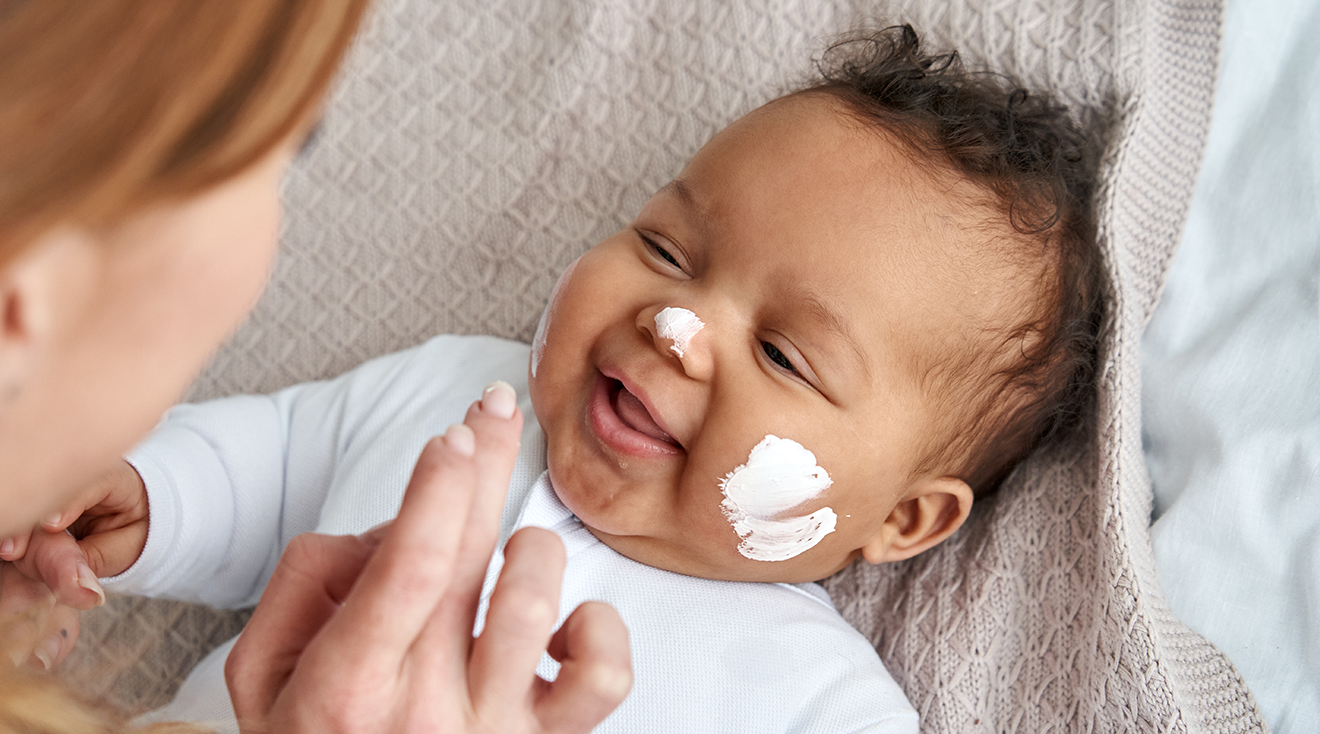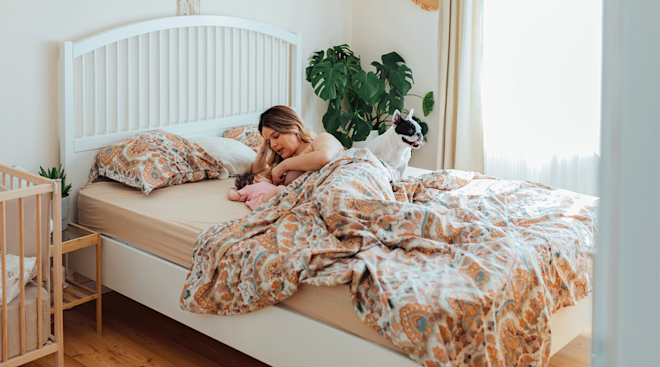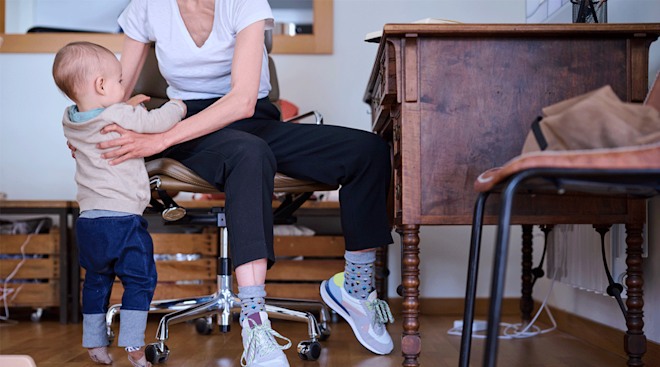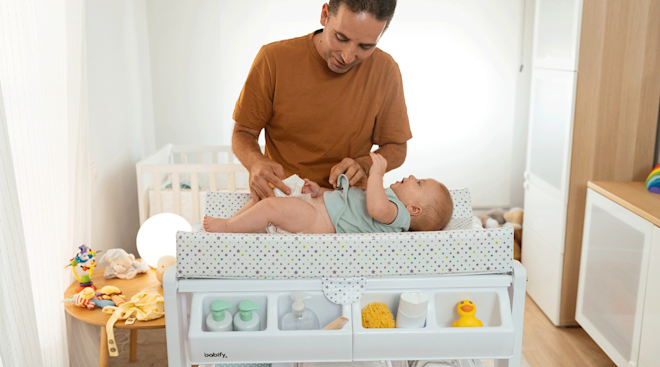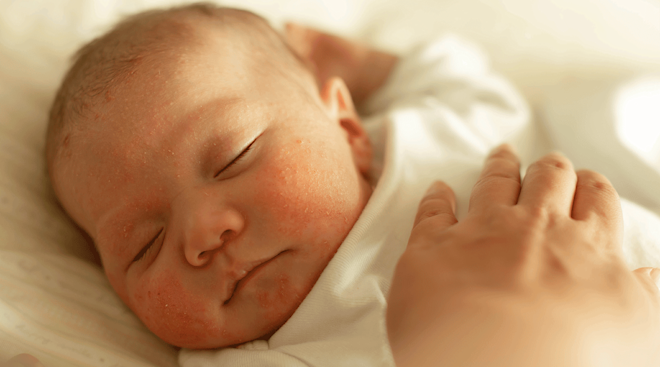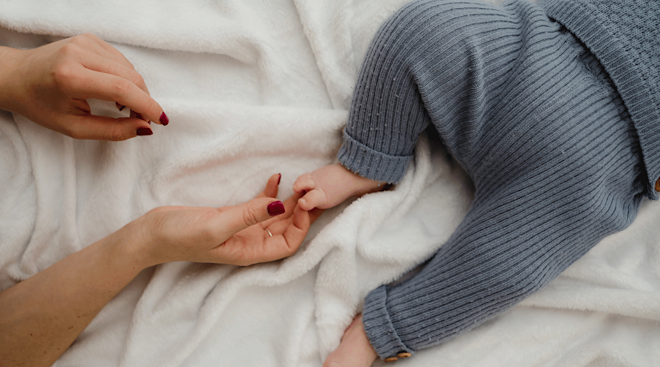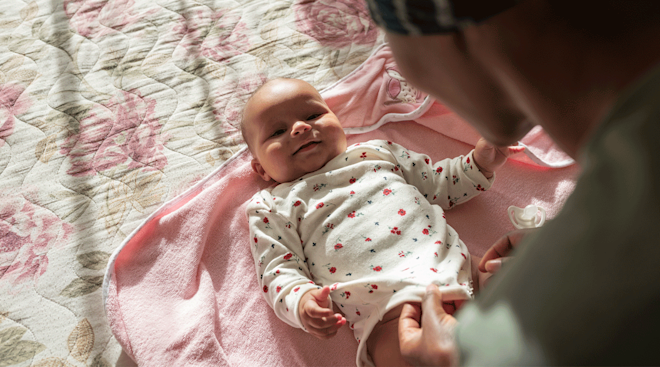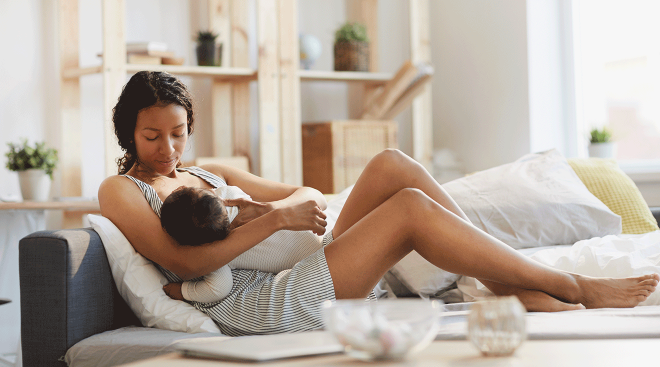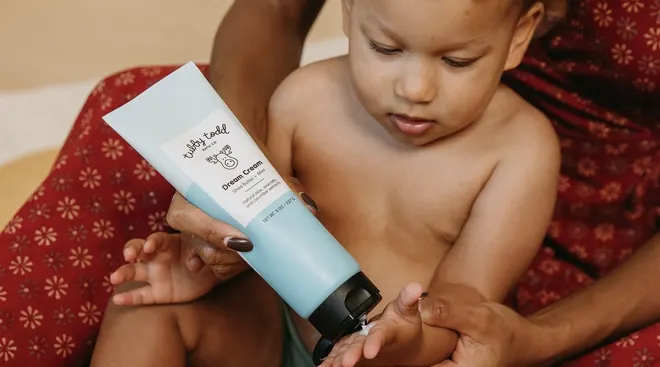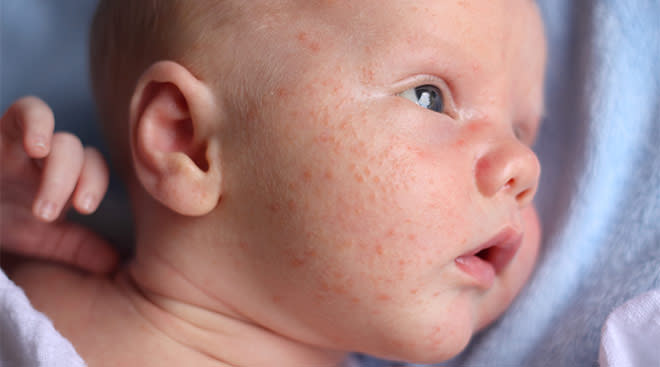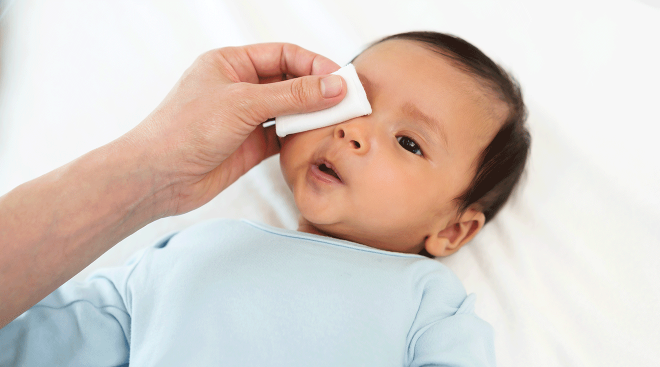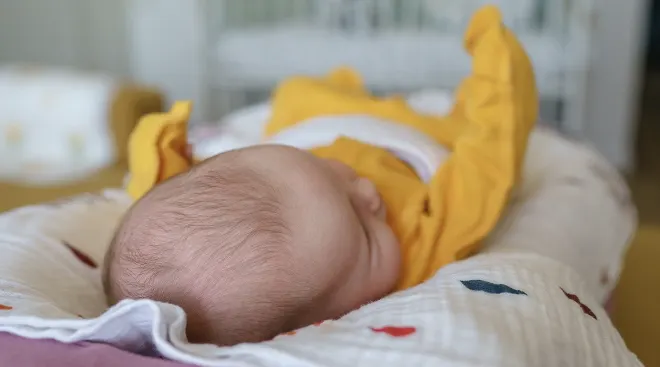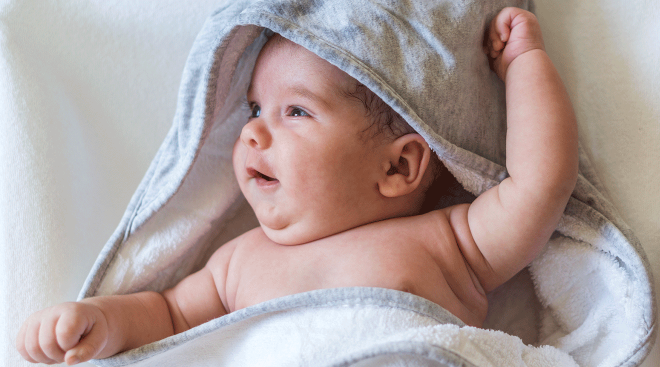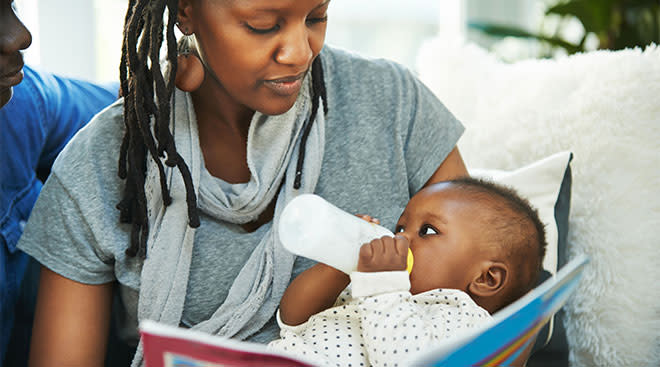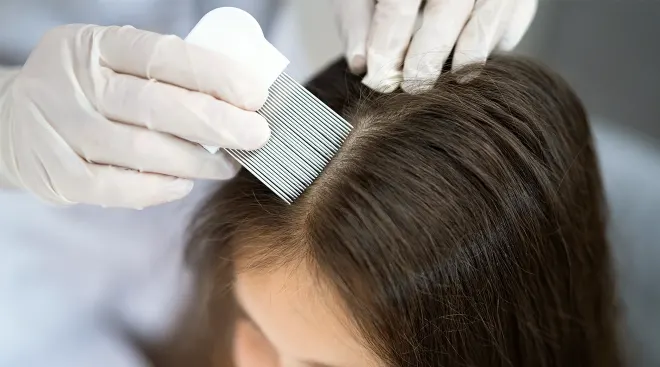Baby Skin Care: When Can You Put Lotion on Infants?
When we think of a baby’s complexion, we think of soft, plump perfection. Of course, that’s not always the case. An infant’s skin continues to develop throughout that first year of life, and it can through many less-than-flawless phases. It might be dry, flaky, sensitive and even have some funky discolorations—especially during the newborn period. So how should you be caring for baby’s sensitive skin? And when can you put lotion on a newborn or infant? Read on to learn how to care for baby’s skin when it’s needing a little extra TLC.
Wondering when to start using baby lotion on your little one? According to Elizabeth Cilenti, MD, MPH, a pediatrician with Northern Virginia Family Practice, you can use baby lotion on newborns from the get go, if you notice any patches of dry or peeling skin. Just be sure to patch test it first and opt for dye-free, fragrance-free and baby-friendly options. And if baby was born prematurely, consult with your pediatrician before using any new products on baby’s skin. Preterm babies may have less developed skin and higher risk of infection, according to Cilenti.
Of course, while it’s safe to use baby lotion, most newborns won’t need it, as they’re born with a white, creamy biofilm known as vernix caseosa. This naturally works to protect and moisturize baby’s skin “far better than any moisturizer product,” Cilenti explains. “It’s part of the reason many hospitals are recommending to delay bathing until 24 hours for many babies—to let the vernix absorb into baby’s skin.”
Again, most babies will only need lotion or other moisturizers if they have dry spots or peeling skin. That said, you may want to proactively apply it after baths too. The exposure to water can dry out baby’s skin, but putting on moisturizer prevents “moisture already in the skin from evaporating,” explains Karl Neumann, MD, a retired pediatrician who previously worked at Forest Hills Pediatric Associates in New York and contributor to Kids Travel Doc. “Apply moisturizers as often as necessary. It’s okay to put thick layers on baby.”
Babies with eczema will need to be moisturized more often—maybe even daily—with a thick, fragrance-free cream or ointment (instead of baby lotion or oil), Cilenti adds. In fact, she doesn’t recommend using baby oil for anything other than baby massage. “It isn’t as effective at moisturizing as a thicker cream or ointment,” she explains.
Moreover, ensure the products you’re using are effective considering your specific climate. Use lighter creams and lotions in warmer climates and thicker creams and petroleum-based products in colder climates, says Nanette Silverberg, MD, chief of pediatric dermatology for Mount Sinai Health System in New York City. Either way, each works best when applied to wet skin, ideally within three minutes of getting out of the bath. If you wait longer, the water will evaporate from baby’s skin, sapping its natural protective oils.
As noted, baby’s skin takes time to develop over their first year of life. “This makes babies more susceptible to damage from the sun, wind, cold and other irritants,” says Estee Williams, MD, a dermatologist in New York City and an assistant clinical professor in dermatology at Mount Sinai. That doesn’t mean you have to swaddle baby in protective bubble wrap until they’re in preschool. Instead, just follow some simple rules for caring for baby’s delicate skin:
Bathe baby less often
Sure, you take a shower every day, but baby really shouldn’t get a daily bath. “Bathing a few times a week is reasonable,” Silverberg says. If you bathe baby too often, you’ll dry out their skin and remove natural oils that help protect them from infections and irritants. Also, be mindful of the water temperature; bathwater that’s too warm can speed up the loss of moisture from the skin’s protective layer, Williams adds.
Spot clean baby as needed
While baths aren’t required for babies, you’ll still need to clean their face, diaper area and folds as often as necessary to wipe away salvia, milk and excrements. “Whenever skin is continuously exposed to any type of moisture, be it milk, sweat, urine, saliva or water, there’s potential to cause redness, chafing and peeling,” Williams explains. And sometimes when moisture builds up it attracts yeast (aka candida), which can make an existing rash worse. To keep your drooly baby’s skin healthy, Williams recommends gently patting their face and in between those cute, chubby rolls with a soft washcloth, when needed but at least twice daily.
Choose gentle products
You probably already know this, but you don’t want to use your adult shampoo and soap on baby. “Until infants are about one year old, it’s best to use soaps and shampoos that are specifically formulated for this age group,” says Neumann. “Generally, these products are ‘nontoxic,’ and free of dyes, deodorants, alcohols and other ingredients that can be harmful to your infant’s skin.” Tear-free formulas are also less likely to irritate baby’s eyes. When you bathe baby, know that some baby soaps don’t provide a ton of lather like your usual soap does, but that doesn’t mean you need to add more—baby’s still getting clean sans suds.
And while you’re at it, forgo the baby powder, as baby could inhale the powder into their lungs. For a dry baby bottom, simply pat it down with a clean towel.
Avoid excessive sun exposure
“Babies produce less melanin, which leads to more sensitivity to the sun,” Williams says. As such, infants under 6 months should wear hats with an all-around three-inch brim, long sleeves and long pants when out and about. Sunscreen isn’t recommended for babies under 6 months old “because they haven’t been tested for this age group yet,” Neumann says. “But most experts believe that in the rare situation where sun exposure is needed for an infant, using sunscreen is safer than not using sunscreen.” If full-on sun is unavoidable, apply a minimal amount of broad-spectrum sunscreen of at least SPF 30 to baby’s face and the back of the hands.
Prewash baby’s clothes
You should always wash baby’s clothes before the first wear, advises the American Academy of Pediatrics (AAP). This practice can help remove any potential store- or factory-borne irritants that could bother baby’s skin. But don’t toss those onesies in the machine with any ol’ soap. “Less is more when it comes to baby detergents—less fragrance, less dyes. You’re looking for gentle ingredients here,” Silverberg notes. You don’t need a special baby detergent, but look for one that’s hypoallergenic and fragrance-free.
Use a baby humidifier
During chilly winter months, it’s not a bad idea to crank a cool-mist humidifier in the nursery. Most indoor heating systems lower relative humidity, leading to dry inside air that can irritate baby’s skin. “A humidifier, however, can raise the water content in the air, which helps to combat some of the drying effects of indoor heat,” Williams says. Bonus: A nighttime humidifier can also keep a runny nose from drying up and causing congestion and discomfort. Just don’t forget to change out the water frequently to avoid mold and bacteria.
Don’t pick at baby’s skin
It’s normal for baby to have rashes, so don’t freak out too much if you spot some irritation on baby’s skin. “In the newborn period, most rashes come and go frequently,” Neumann says. “The most common are acne-type rashes on the face; ‘flea bite’ type spots all over the body; and dry, peeling skin similar to sunburns.” If you get the urge to self-treat these blemishes, don’t, advises Silverberg—that’ll simply irritate baby’s skin more. Instead, talk to baby’s pediatrician about skin changes and rashes. Chances are, it’s no big deal, but they’ll help you get to the root of the problem.
Know the signs of a skin infection
There are certain conditions, like bacterial folliculitis or toddler acne, that need medical attention, Silverberg notes. “In cases of severe or persistent rashes, it’s best to consult with your pediatrician or a pediatric dermatologist.” Plus, keep an eye out for signs of infection, including pustules; boils; very red and raw areas on diaper rashes; cracked and bleeding skin; and yellow crusting on the skin. “Contact your pediatrician if your infant has a rash accompanied by fever and is excessively cranky,” advises Neumann.
You’ll also want to watch baby’s birthmarks. These are pretty common for babies to have and are usually harmless, but you should keep an eye on them for any changes. The AAP recommends consulting baby’s pediatrician if baby has a birthmark that changes.
Frequently Asked Questions
Can you put lotion on a newborn’s face?
Yes, you can put lotion on a newborn’s face, Cilenti says. In fact, she recommends creating a barrier between baby’s saliva and skin with a thick ointment as baby starts teething and drooling. “Some babies will get dry skin on their cheeks or under their chins from saliva….[which] contains digestive enzymes that help break down food. These can be irritating to baby's soft skin.” You can opt for something simple here to act as a barrier, such as Vaseline.
Is it better to use baby powder or lotion on baby?
As mentioned, experts no longer recommend using baby powder due to the risk of inhalation. “Modern diapers are so absorbent that babies don't need baby powder to absorb liquid and prevent rashes,” Cilenti explains. “Skip the baby powder. Lotions, creams and ointments are all okay.”
Is it safe to use adult body lotion on baby?
It’s best to use skin care products specifically formulated for babies on baby’s skin, as adult products may “contain fragrances and other additives that are too harsh for baby's soft skin,” Cilenti notes.
Moisturizing baby can be a big part of their infant skin care routine, especially if your little one struggles with any skin conditions. If you’re hesitant about the best products to use or how often to lather up your little one with cream, reach out to your pediatrician for personalized guidance.
Please note: The Bump and the materials and information it contains are not intended to, and do not constitute, medical or other health advice or diagnosis and should not be used as such. You should always consult with a qualified physician or health professional about your specific circumstances.
Plus, more from The Bump:
Elizabeth Cilenti, MD, MPH, is a pediatrician with Northern Virginia Family Practice. She completed her medical degree and residency at Indiana University School of Medicine and her master’s degree in public health at the Harvard T.H. Chan School of Public Health.
Karl Neumann, MD, was a retired pediatrician who worked at Forest Hills Pediatric Associates in New York City and served as a contributor to Kids Travel Doc. He earned his medical degree from the State University of New York Upstate Medical University.
Nanette Silverberg, MD, is chief of pediatric dermatology for Mount Sinai Health System in New York City. She is also a clinical professor of pediatrics and dermatology at the Icahn School of Medicine at Mount Sinai. She graduated Summa Cum Laude with commendation in research from the SUNY Downstate Medical School.
Estee Williams, MD, is a medical, cosmetic and surgical dermatologist who treats adult and pediatric patients in New York City. She also serves as an assistant clinical professor in dermatology at Mount Sinai. She received her medical degree from Albert Einstein College of Medicine and completed her dermatology residency training at SUNY Downstate Medical Center.
Healthy Children (American Academy of Pediatrics), Cleaning Baby Clothes, November 2009
Healthy Children (American Academy of Pediatrics), Baby Birthmarks and Rashes, March 2019
Learn how we ensure the accuracy of our content through our editorial and medical review process.
Navigate forward to interact with the calendar and select a date. Press the question mark key to get the keyboard shortcuts for changing dates.

































